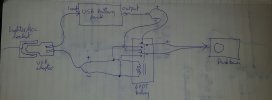So basically, we are talking about alternative budget way to power a car dash camera in parking mode.
I would assume this? because Cellink B battery pack is way too expensive for what it is and what it does? (I would buy if price is at least half).
So anyways, I was thinking but I can't get it out of my head. So I'll just blur it out and maybe someone can complete my idea or have better idea?
Sure it would be nice to be able to charge a device & have its battery pack recharge at same time. BUT, looking through the Anker's site (I personally prefer & own few battery packs which utilize 18650 cells), their newer models have disabled ability to use input/output at same time.
This is a direct quote from Anker,
"No, we have disabled this feature due to the detrimental effects it has on the lifespan of external batteries."
So my idea isn't great and I can't fully picture it but... for those who do NOT have it hardwired like myself (maybe hardwired too) but want a parking mode or camera On full time can simply unplug and plug in a battery pack, right? But that would be so extremely inconvenient. In my case, I would very likely even forget about doing it. Plus, one would need to recharge the battery pack seperately, even more inconvenience.
So how about slightly simplify it by placing a some sort of toggle switch between power source from car to battery pack to camera? (this is where I can't clearly think out the idea, so you help would be awesome).
I guess what I am trying to think of is...
Position A, (for when car is ON), (voltage cut-off would be required in case one forget to toggle switch)
+dash camera is powered from car,
+recharge battery pack from car,
Position B, (for when car is OFF/Parking Mode)
+dash camera is powered from battery pack,
+stop charge to battery pack.
Ex:
(A) = wire between CarPowerSource to BatteryPack
(B) = wire between CarPowerSource to Camera
(C) = wire between BatteryPack to Camera
So...
Position A (car ON): (A),(B) connected.
(C) disconnected
Position B (car OFF): (A),(B) disconnected.
(C) connected.
This should prevent allowing battery pack to input/output same time (whether or not Anker said feature is disabled, for peace of mind)
So what would be the easiest? simplest? safest? way to wire this up? Or a switch-less idea?
I guess, most important thing for anyone is to remember to switch the toggle each and every time? At least a lot simpler than unplug, pluggin'.
Maybe someone have a idea to automate this process when ignition is ON?OFF? or whatever other creative ways to get same result? Purchaps something that would avoid messing with wires to fuse box as much as posible?
I bet, some of you would say... just pay up and get the CellinkB battery pack. Right?

Anyways, if anyone with better? cleaner? simpler? method can add on to this would be greatly appreciated.
ps, since these battery packs are very affordable, I would personally replace them maybe once every 1 or 2 years. (i think recharge cycle life is around 300?? or so?)


